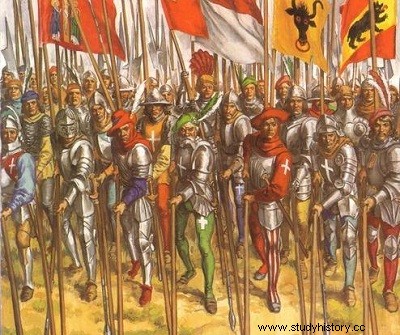
A pike is a polearm, a long spear carried by an infantryman, primarily intended to counter cavalry charges.
We can distinguish two periods, where it was a major weapon:
in ancient Greece, where the Macedonian phalanx carried long pikes called sarisses, three to seven meters long (the pike designation is however rather retroactive),
the late Middle Ages and the Renaissance, where it was reintroduced by the Scots and the Swiss, from the battle of Bannockburn in 1314 and that of Sempach in 1386.
The invention of the bayonet, at the end of the 17th century, made the pike obsolete, because it allowed the musketeer to defend himself against cavalry.
Example of units with spikes:
the Macedonian phalanx;
the lansquenets;
the Spanish tercios.
Spades made their appearance in France at the beginning of the 16th century, it remained in the army until the end of the 17th century.
Under the French Revolution, the pike was again used as a weapon by the common people. In July 1792, Lazare Carnot suggested giving the people all the pikes kept in the arsenals and ordering the manufacture of three hundred thousand other pikes. During the Days of October 5 and 6, 1789, Parisians were generally armed with these pikes. The heads of certain people decapitated by the insurgents were sometimes placed at the end of this cold weapon, such as those of Bernard-René Jordan de Launay, Jacques de Flesselles, Joseph Foullon de Doué, Louis Bénigne François Berthier de Sauvigny. At the end of 1793, the Minister of War thought he was doing the right thing by arming several battalions with pikes:the enemy troops armed with rifles[Who?] made short work of it.
